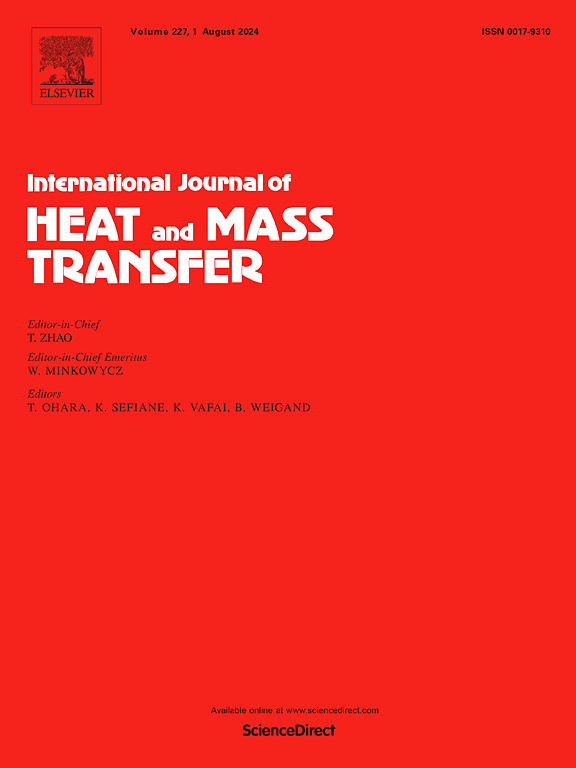模拟两相不饱和蒸发过程的连续热通量相变模型
IF 5.8
2区 工程技术
Q1 ENGINEERING, MECHANICAL
International Journal of Heat and Mass Transfer
Pub Date : 2025-05-02
DOI:10.1016/j.ijheatmasstransfer.2025.127187
引用次数: 0
摘要
准确模拟液-汽传质速率对于优化对推进未来太空任务至关重要的低温流体管理过程至关重要。本文提出了一种模拟两相不饱和蒸发现象的连续热通量相变模型。通过两相界面的传质速率直接基于液相和气相的局部界面连续热通量计算,有效地考虑了过热、饱和和过冷的液体效应,而不需要任何经验调节参数。此外,相变只发生在界面单元内,确保了变形蒸发界面的清晰表征和高精度。提出的模型使用ANSYS Fluent中的用户定义函数实现,并针对各种基准蒸发问题进行了评估,包括单相和两相非平衡(非饱和温度)的Stefan和膜沸腾测试用例。数值结果,包括液-汽界面演化和温度分布,与已发表的解析解和数值解非常吻合。应用该模型模拟了低温储罐在蒸汽加热和均匀加热两种加热方式下的复杂传热传质过程。结果与文献中报道的罐压上升趋势吻合良好,验证了该模型对实际蒸发情景的适用性。本文章由计算机程序翻译,如有差异,请以英文原文为准。

A continuous-heat-flux phase change model for simulating realistic two-phase unsaturated evaporation processes
Accurately modeling liquid-vapor mass transfer rates is essential for optimizing cryogenic fluid management processes critical to advancing future space missions. This study introduces a continuous-heat-flux phase change model proposed to simulate conditions observed in realistic two-phase unsaturated evaporation phenomena. The mass transfer rate across the two-phase interface is calculated directly based on the local interfacial continuous heat flux on both liquid and vapor phases, effectively accounting for superheated, saturated, and subcooled liquid effects without requiring any empirical tuning parameters. Moreover, phase change occurs exclusively within interfacial cells, ensuring the sharp representation of deformed evaporating interfaces with high accuracy. The proposed model is implemented using user-defined functions in ANSYS Fluent and evaluated against various benchmark evaporation problems, including Stefan and film boiling test cases with nonequilibrium (temperature other than saturation) in a single phase and in both phases. The numerical results, encompassing liquid-vapor interface evolution and temperature distributions, exhibit excellent agreement with published analytical and numerical solutions. Additionally, the model is applied to simulate the complex heat and mass transfer processes in cryogenic tank self-pressurization under two heating configurations: vapor heating and uniform heating. The results demonstrate good agreement with the tank pressure rise trends reported in the literature, validating the applicability of the model to practical evaporation scenarios.
求助全文
通过发布文献求助,成功后即可免费获取论文全文。
去求助
来源期刊
CiteScore
10.30
自引率
13.50%
发文量
1319
审稿时长
41 days
期刊介绍:
International Journal of Heat and Mass Transfer is the vehicle for the exchange of basic ideas in heat and mass transfer between research workers and engineers throughout the world. It focuses on both analytical and experimental research, with an emphasis on contributions which increase the basic understanding of transfer processes and their application to engineering problems.
Topics include:
-New methods of measuring and/or correlating transport-property data
-Energy engineering
-Environmental applications of heat and/or mass transfer

 求助内容:
求助内容: 应助结果提醒方式:
应助结果提醒方式:


